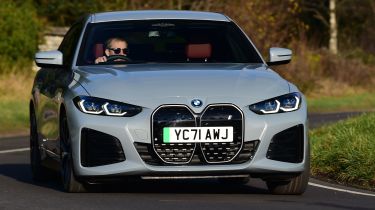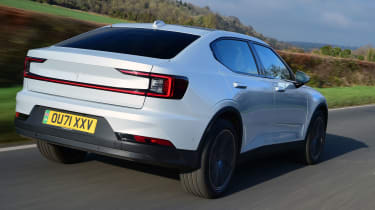BMW i4 vs Tesla Model 3 vs Polestar 2: performance and handling
The i4 excels in this company as the true driver’s EV, as well as offering refinement and ride comfort that make it great on longer journeys

The BMW i4 is quite simply one of the best EVs for keen drivers currently on sale, at any price. The electric Gran Coupe’s steering is wonderfully precise and has the most natural weighting of this trio. The i4 turns into corners keenly, without any hint of understeer. There’s also just enough body lean to let the driver know how much grip there is – and most of the time there’s plenty, unless you get too enthusiastic with the throttle.
The i4 is available in full-bore M50 form, with a dual-motor setup packing 537bhp, but there’s still plenty on tap in the eDrive40. All 335bhp and 430Nm of torque is deployed through the rear wheels, and there’s a gentle, progressive amount of slip. All in all, the i4 offers the level of feel and driver engagement that you’d expect from the BMW badge.
But it can do more than dominate a British B-road: the i4 also manages to be the most comfortable car here by quite some margin. Flick the dampers into comfort mode and there’s none of harshness or fidgeting present in the other two. Plus, wind and tyre noise are kept at bay in the BMW, which makes it the most relaxing option here, whether in town or on long journeys.
You can only option the £5,000 Performance Pack on the top-of-the-range, dual-motor Polestar 2, but potential buyers needn't worry, because the Long Range Single Motor drives neatly enough without it. No, it can’t match the BMW for fun, but the Polestar still feels level and stable through the corners – more so than the Tesla. However, its body control isn’t as tight as i4’s, and while the steering is precise, it’s quite light and doesn’t offer much in the way of feedback.
The Polestar stays flat in corners thanks to what feels like the firmest suspension of the three, but a side-effect of that setup is the Tesla and BMW handle larger bumps better. Although it must be said, the Polestar does iron out smaller imperfections better than the Tesla.

Sadly, the perceived sportiness that comes with the firm suspension isn’t backed up by straight-line performance. While it also uses a single electric motor, like the i4, this particular Polestar produces just 228bhp, all of which is sent to the front wheels only. That’s enough for a 0-62mph time of seven seconds flat. The svelte-looking Swede is by no means gutless, however it is comfortably the slowest EV in this company. Ultimately, the Polestar shines when driving around town, which is easy thanks to a mix of light steering, great visibility and a tight turning circle.
But of the three here, the Tesla feels like it has the least sophisticated suspension and chassis. Over big bumps, the American car is certainly the softest in this test, but it’s undermined by a constantly fidgety ride even across surfaces the BMW barely acknowledges. It’s also noisier than the i4, in terms of both tyre roar and the sound of bumps from the suspension permeating the cabin.
Things do improve at higher speeds, as the overall softness and combination of soft seats and low wind noise make the Model 3 great for covering miles on the motorway. It’s once you come across a more exciting road that the Tesla’s limits show.
There’s no denying that it’s very effective at covering ground thanks to its dual-motor setup. There’s a total of 434bhp and 493Nm on tap and grip is excellent, so it’s not surprising you can do 0-62mph in nearly four seconds driving this somewhat sedate-looking saloon. Beyond bragging rights, it’s hard to see why anyone would ever need the even faster Performance variant, given just how rapid the Long Range is.
Unfortunately, the Model 3 is let down by its steering, which not only lacks feel, but also has an unnatural quality. It feels more like you’re twirling the wheel of an arcade game than something connected to the tyres. This effect is at its worst in Sport mode, but in any setting you can feel like you’re fighting against it, even when it’s not really loaded up. The brake regeneration can be quite harsh, too, which means you have to be very precise when backing the throttle off-mid corner if you don’t want the car to rock against its soft springs.



